P. Marlin Copyright July 2017
The Trinity Lutheran Church, located at 700 South Hickory Street in Centralia, Illinois is now a shell of a building. Beyond repair, its once lively structure is now condemned to a fate of rubble in the not too distance future. Literally the center of many people's lives for years, the church was surrounded by the homes of families who had immigrated from Germany to the United States in the mid to late 1800's. These immigrants were looking for religious freedom and new opportunities in America. This blog entry is a look into the history of the Trinity Lutheran Church, its devout German Lutheran founders, and their families who lived in Washington, Clinton, and Marion Counties. For me, personally, several of the founding fathers of the church were my ancestors, so it is a genealogical journey as well.
 The Trinity Lutheran Church on South Hickory and Seventh Streets in Centralia, Illinois in 1927. 5
The Trinity Lutheran Church on South Hickory and Seventh Streets in Centralia, Illinois in 1927. 5
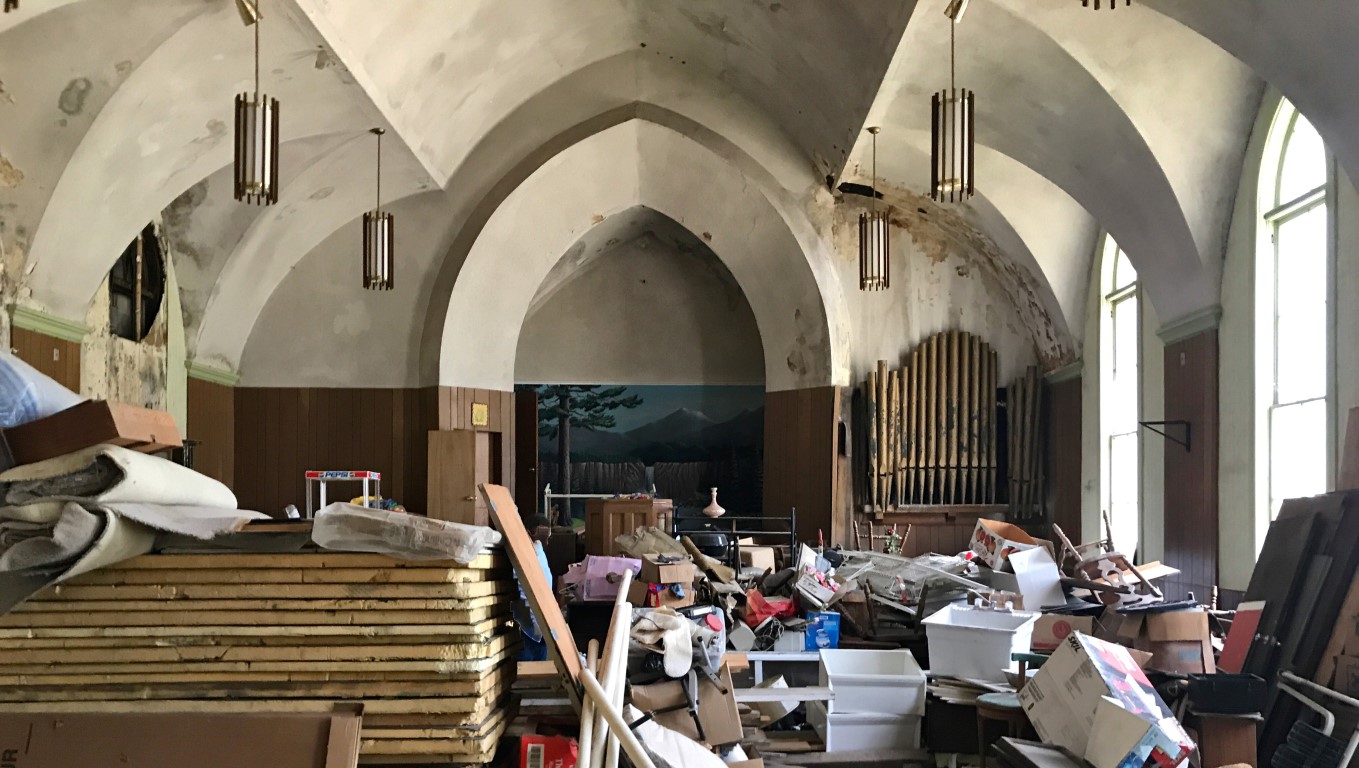 The present condition of the church.
The present condition of the church.
With economic and political uncertainties among the main reasons that Germans left the fatherland, there was also the desire for religious freedom. In 1817 Frederick William III, King of Prussia, issued a decree declaring that the Lutheran and Reformed churches would be joined into one Evangelical Christian Church. From 1821-1830, additional decrees from the King forced the churches to follow a new agenda of worship. Rejecting the new decrees set out by the Prussian government and king, the 'Old Lutherans' (a term referring to those who rejected the new form of religious worship) decided to continue teaching in the traditional ways of the Lutheran church. As a result, pastors and laymen were either imprisoned or persecuted and many decided to flee the country.
German immigration to the United States began in the 1700's, however, it wasn't until after 1830 that southern Illinois saw an increase in the German population. With the availability of cheap land in the Mississippi Valley, and publications like "Report on the Journey to the Western States of North America" by Gottfried Duden (a Prussian lawyer) describing of the pleasures of pioneer life in the United States, Illinois quickly became a destination of choice.
Several ports of entry into the United States were made available for German immigrants heading to Illinois. One of the earliest ports of entry was Baltimore, Maryland. From Baltimore, immigrants could travel by way of the national road from Cumberland to Wheeling, where many took passage on the Ohio River. From New York, they would travel by way of the Hudson River to Albany, then via the Erie Canal to Buffalo and Cleveland where they would steamboat into St. Louis. After 1835, the busiest port of entry for immigrants became New Orleans, Louisiana. With a trip up the Mississippi River, this route was the easiest and least expensive. Below are the passenger lists for the arrival of three of the Trinity Lutheran families into America, Friedrich Voigt, Henry Hoeinghaus and Valentine Gutzler. 1
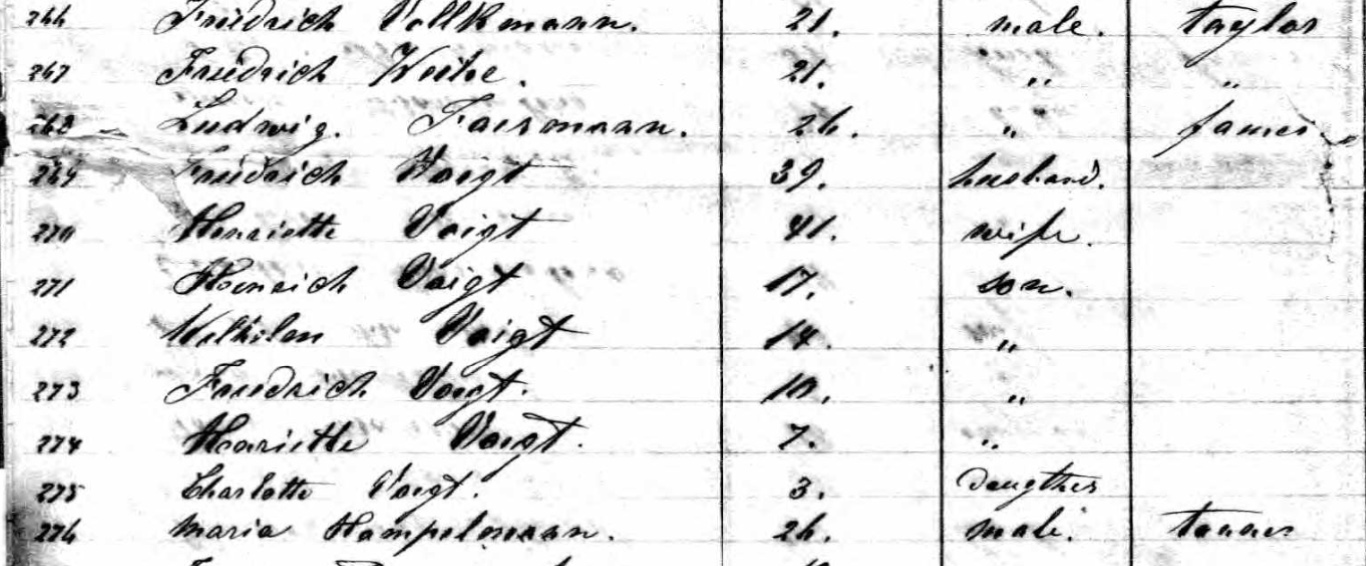 This passenger list shows the Friedrich Voigt family arriving in New Orleans, Louisiana in 1867. The family settled in Washington County, Illinois.
Daughter Charlotte Voigt (my 3rd great-grandmother), married Henry Hoeinghaus and settled in Centralia, Illinois. Members of the Voigt family were
also founders of the Trinity Lutheran Church in Centralia.
This passenger list shows the Friedrich Voigt family arriving in New Orleans, Louisiana in 1867. The family settled in Washington County, Illinois.
Daughter Charlotte Voigt (my 3rd great-grandmother), married Henry Hoeinghaus and settled in Centralia, Illinois. Members of the Voigt family were
also founders of the Trinity Lutheran Church in Centralia.
The Hoeinghaus family arrived in southern Illinois in 1880. Henry Hoeinghaus was one of the founders of the Trinity Lutheran Church in Centralia.
 This passenger list shows Valentine Gutzler, father of Fred (founder of Trinity Lutheran), Henry, Caroline (married to founder William Toenningsmeyer)
and John Gutzler arriving in New Orleans, Louisiana.
This passenger list shows Valentine Gutzler, father of Fred (founder of Trinity Lutheran), Henry, Caroline (married to founder William Toenningsmeyer)
and John Gutzler arriving in New Orleans, Louisiana.
 The 1880 Illinois census shows William Toenningsmeyer and his wife Caroline (Gutzler) living in Irvington, Illinois. William Toenningsmeyer was one of the
founders of the Trinity Lutheran Church in Centralia.
The 1880 Illinois census shows William Toenningsmeyer and his wife Caroline (Gutzler) living in Irvington, Illinois. William Toenningsmeyer was one of the
founders of the Trinity Lutheran Church in Centralia.
Many of the German families who settled in southern Illinois were from Minden, Province of Westphalia, in the Kingdom of Prussia (as indicated in the 1860, 1870 and 1880 census surveys of Illinois). Once they settled in their new location, they called it New Minden as a reminder of their old home. These growing German families branched out into Washington county's Nashville, Hoylton, and Irvington, as mainly farmers and coal miners.
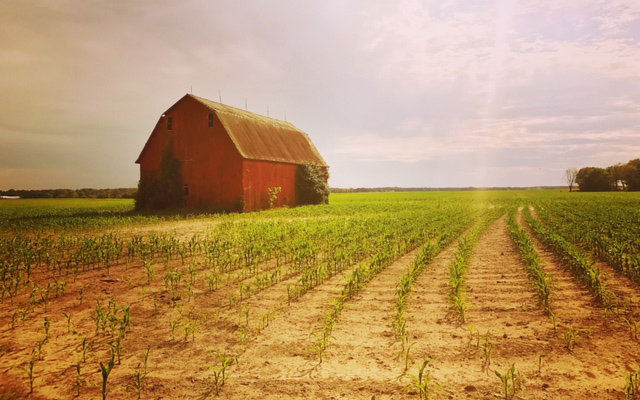 An old barn located near New Minden, Illinois. Photo by Pam Marlin.
An old barn located near New Minden, Illinois. Photo by Pam Marlin.
With more German Lutherans, Trinity Lutheran churches began filling the southern Illinois landscape. The text below, taken from "Golden Jubilee" Trinity Lutheran Church 1892 - 1942 Centralia, Illinois," describes the start of Lutheranism in the area:
"The Hanoverians living near the city of Minden in Germany established a new colony here in Southern Illinois and called it New Minden. The founding of this congregation in the year 1840 was the beginning of Lutheranism in this section. Organized as a congregation in 1845, it grew and spread. A new congregation was founded at Hoyleton. Some years later another congregation was started at Hoffmann. Finally, in the year 1892, Trinity Church was founded in Centralia and the constitution adopted in April of that year."
In 1891 German Lutherans, ministered to by the Reverend Katthein of Hoyleton, began holding church services in Turner Hall on South Walnut Street in Centralia (1867 Centralia Map Turner Hall is #10 on the map). In 1892 the congregation had become large enough that members decided to establish a church. The charter and founding members were: F. Gutzler, F. Homberg, William Toenningsmeyer, William Knollman, L. Kruckemeyer, L. Tuegel, Henry Voigt, Henry Harting, Carl Warmbrod, H.C. Schnake, Henry Hoeinghaus, F. Brockschmidt, Casper Meyer and Fred Knipping (I've highlighted my family members). Having organized the congregation, these members decided to build a church on the corner of Seventh and South Hickory Streets. The cornestone of the church was laid on June 12, 1892, and the church was dedicated on October 23 of the same year.2
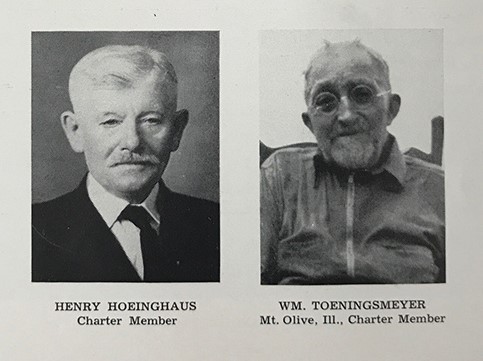 Two of the founding members of the Trinity Lutheran Church (my 3rd great-grandfathers).
Two of the founding members of the Trinity Lutheran Church (my 3rd great-grandfathers).
For the first few years the church struggled without a local pastor, but continued to be served as a mission congregation by Rev. Katthain. With a desire to start a school, the congregation decided to hire a permanent pastor and named to the position Rev. E.A. Knorr, who was officially installed in March 1897. After the new pastor arrived, the church added a schoolroom to the back of the church (as seen in the photo below), and Pastor Knorr began teaching school with thirty-one pupils. The church and the school both experienced steady growth, and in 1906, the church decided to move the present church across the street as a dedicated school building and build a bigger sanctuary at the main location of South Hickory and Seventh Streets. The school continued to grow once it had its own building, and in 1909 they engaged a full-time teacher, Ed Streufert.2 3
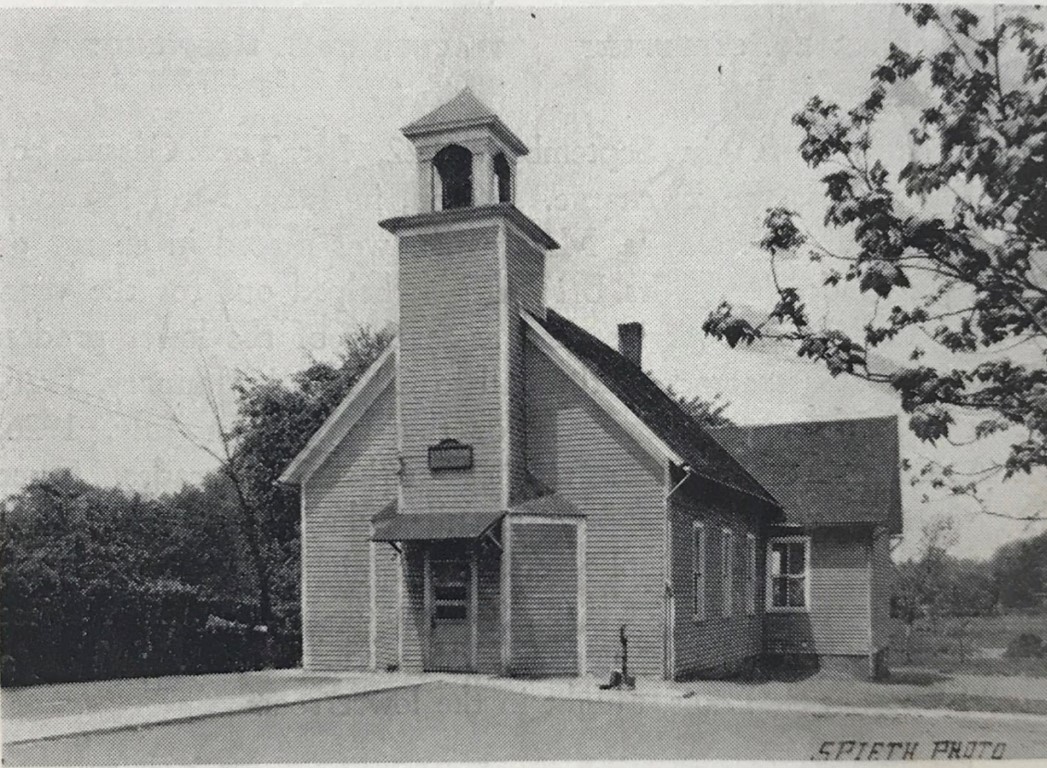 This building was the first Lutheran church at South Hickory and Seventh Streets. In 1906 this building was moved across the street to the 600 block to
serve as the Lutheran Christian Day School and a second church was built on the site of South Hickory and Seventh. 5 My great-grandfather, Sylvester Johnson, attended this school.
This building was the first Lutheran church at South Hickory and Seventh Streets. In 1906 this building was moved across the street to the 600 block to
serve as the Lutheran Christian Day School and a second church was built on the site of South Hickory and Seventh. 5 My great-grandfather, Sylvester Johnson, attended this school.
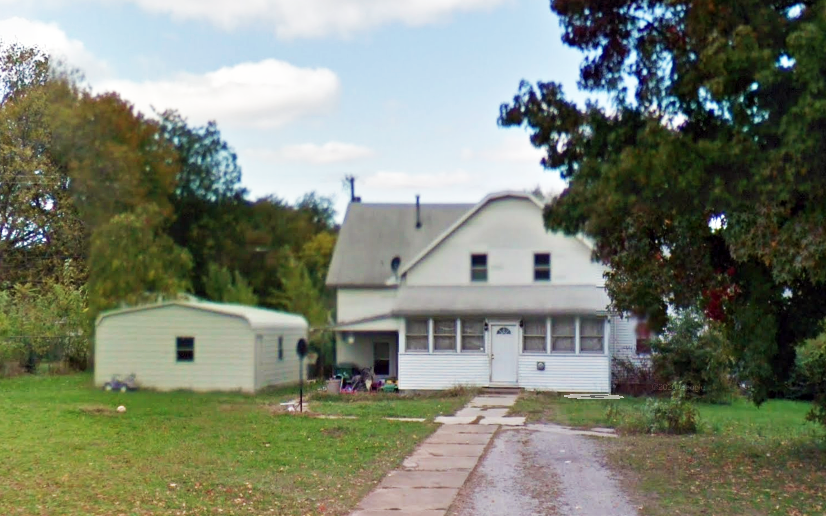 The school has since been remodeled into a house. P Marlin
The school has since been remodeled into a house. P Marlin
The cornestone for the new church building was laid November 4, 1906 and in the same month a new pastor was installed, Rev. W.G. Hussmann. The new church, a brick veneer building, was built at the cost of $10,000 and was dedicated on June 2, 1907. By 1926, sermons were still in German, but with the church attendance up to 620 members, the church decided to offer two services on Sunday morning, one in German for the older members, and one in English for the younger members.
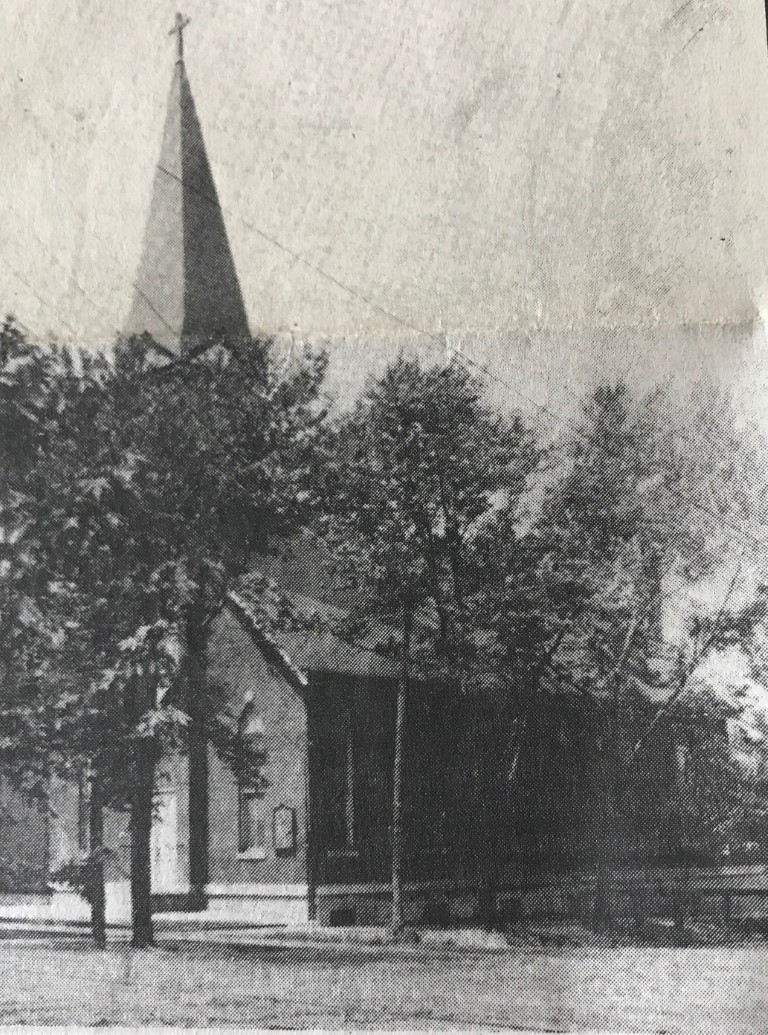 The second Lutheran church that was built at the original location in 1906. 12
The second Lutheran church that was built at the original location in 1906. 12
 The same view in 2017.
The same view in 2017.
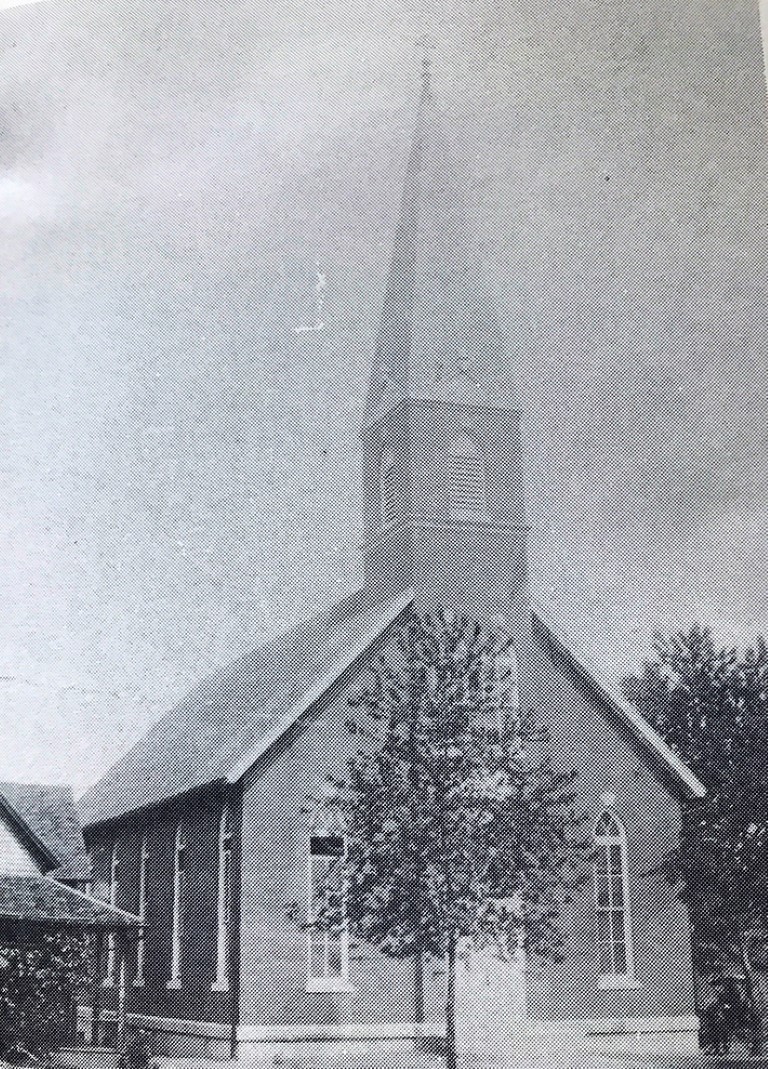 Front view of the church. 5
Front view of the church. 5
 The same view in 2016. The interior and exterior have gone through extensive renovations over the years.
The same view in 2016. The interior and exterior have gone through extensive renovations over the years.
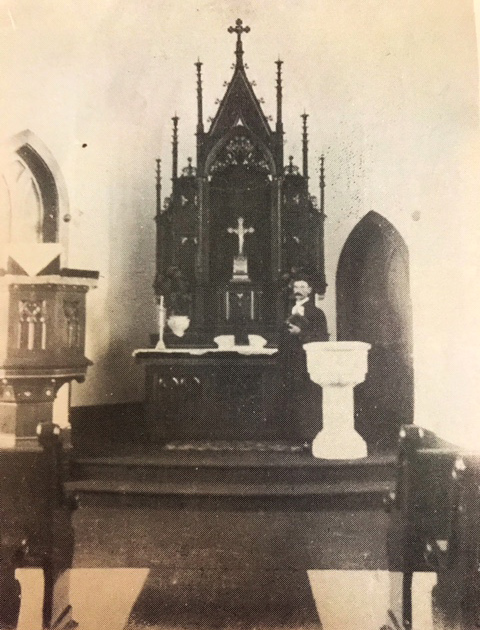 A photo of Rev. Knorr in the 1906 church. Notice the white baptismal in front of Rev. Knorr. This limestone baptismal font was made by Julius Rebstock in 1906
and is now on display at the current Trinity Lutheran Church on Pleasant Avenue in Centralia. 5
A photo of Rev. Knorr in the 1906 church. Notice the white baptismal in front of Rev. Knorr. This limestone baptismal font was made by Julius Rebstock in 1906
and is now on display at the current Trinity Lutheran Church on Pleasant Avenue in Centralia. 5
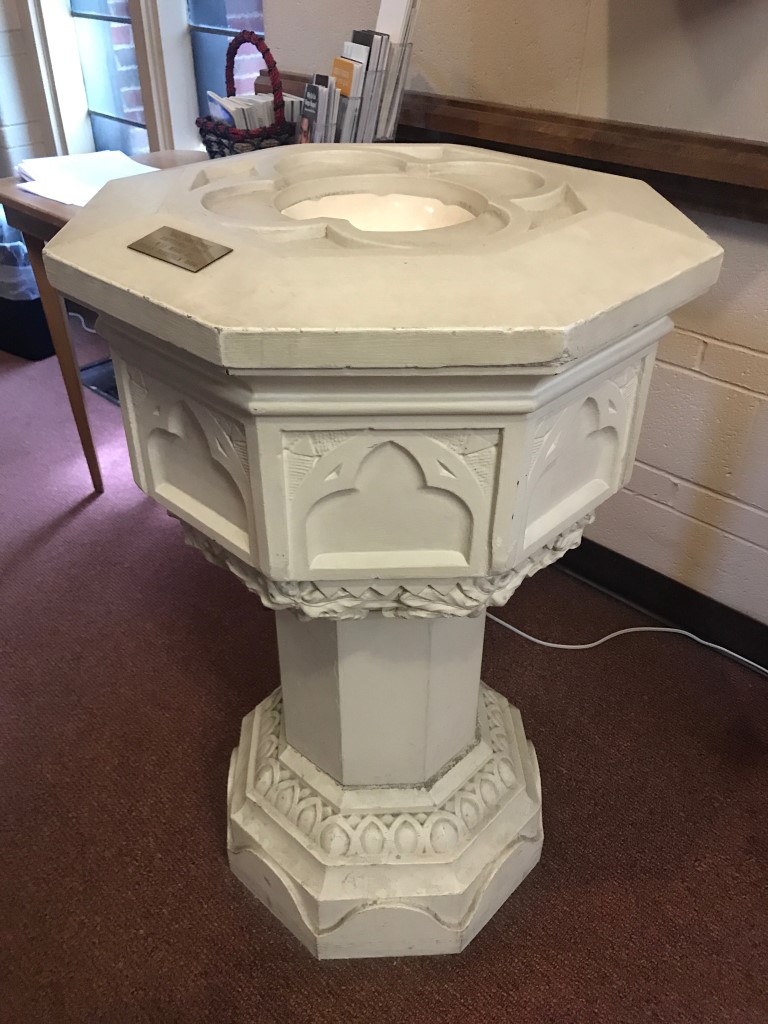 The original white baptismal font made in 1906 that stood in the original church (above photo with Rev. Knorr), is on display in the vestibule of the current church's location on South Pleasant Street.
This baptismal font is described by family member Frances Maroon Johnson (Sylvester's wife) in her book,
Acres of Diamonds, "The pastor poured the baptismal bowl full, and as I held my head over, he dipped the
water with the palm of his hand and gently poured it over my head."
The original white baptismal font made in 1906 that stood in the original church (above photo with Rev. Knorr), is on display in the vestibule of the current church's location on South Pleasant Street.
This baptismal font is described by family member Frances Maroon Johnson (Sylvester's wife) in her book,
Acres of Diamonds, "The pastor poured the baptismal bowl full, and as I held my head over, he dipped the
water with the palm of his hand and gently poured it over my head."
 A new organ was installed in 1926. 3
A new organ was installed in 1926. 3
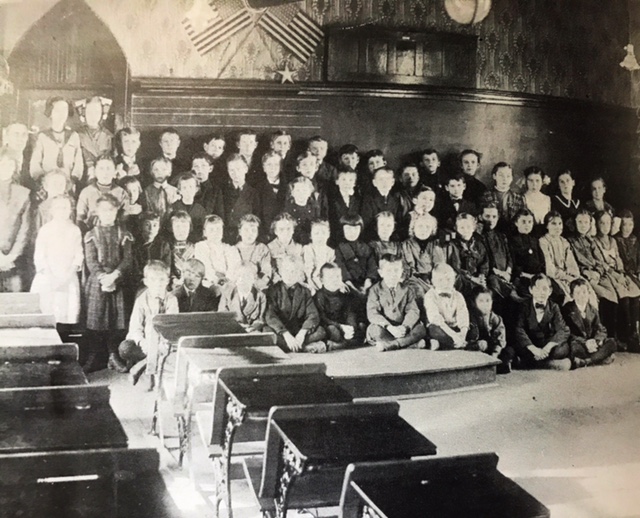 Trinity Lutheran Christian Day School. 5
Trinity Lutheran Christian Day School. 5
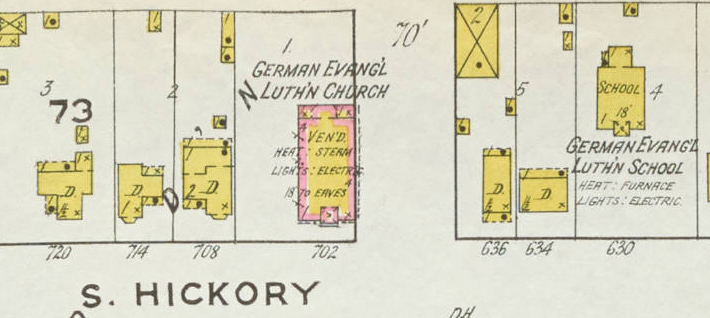 A 1916 plat map for Centralia shows the location of the church and the school on South Hickory.
A 1916 plat map for Centralia shows the location of the church and the school on South Hickory.
The 1895, 1900, 1904 and 1920 Centralia city directories show a majority of the Trinity Lutheran families living on South Cherry and South Hickory streets. Besides the Toenningsmeyer, Hoeinghaus, and Gutzler families, the Knollman, Knipping, Meyer and Brockschmidt families also lived on the same streets. Some family members still own houses on those streets in 2017.
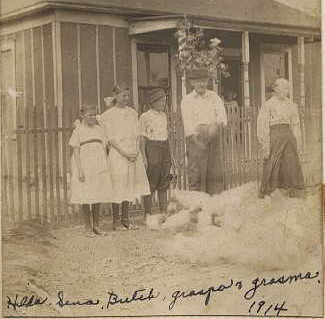 Henry Hoeinghaus (grospa), his wife Charlotte Voigt (grosma), daughters, and grandson Sylvester (Butch) Johnson.
Henry Hoeinghaus (grospa), his wife Charlotte Voigt (grosma), daughters, and grandson Sylvester (Butch) Johnson.
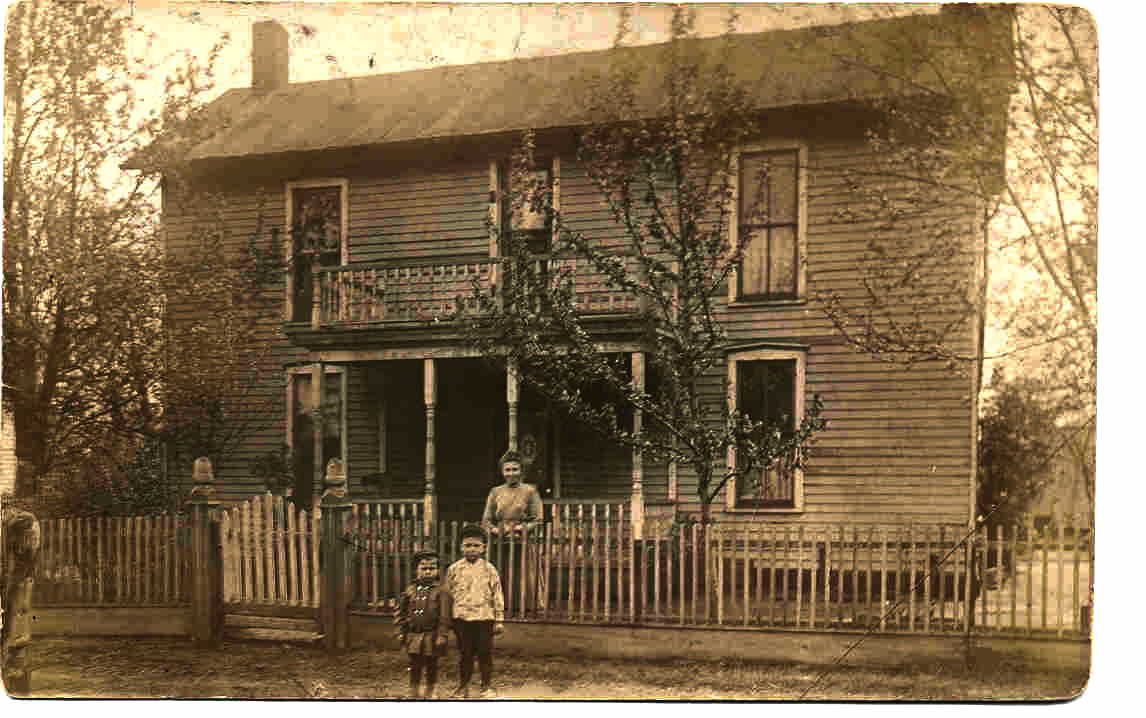 One of the Gutzler families in front of their house in Centralia. 5
One of the Gutzler families in front of their house in Centralia. 5
The 1895 Centralia directory lists William Toenningsmeyer at 724 South Hickory, Henry Hoeinghaus at 707 South Cherry located directly behind the church, and Henry's brother, William Hoeinghaus, living across the street from the church at 713 South Hickory.
The 1920 Centralia City Directory listed the following Gutzler family members:
Miss Frances Gutzler, works Envelope Factory, 726 S.Hickory
Fred Gutzler, wife Linda, miner No. 5 mine, 740 S.Cherry
Harry Gutzler, miner No.5 mine, 706 S.Cherry
John Gutzler, wife Minnie, miner No.5 mine, 706 S. Cherry
John H.Gutzler, wife Lydia, miner No.5 mine, 721 S.Cherry
J.W. Gutzler, wife Emily, miner No.5,712 S. Cherry
Paul Gutzler, miner No. 5 mine, 400 S. Cherry
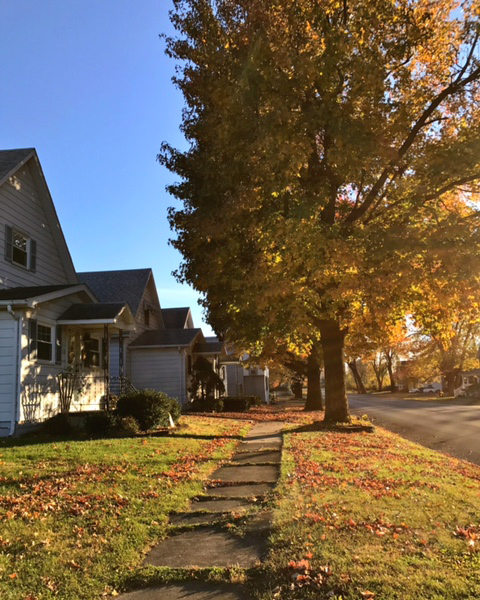 Looking south on South Hickory Street. William Hoeinghaus lived at 713, the first house on the left.
Looking south on South Hickory Street. William Hoeinghaus lived at 713, the first house on the left.
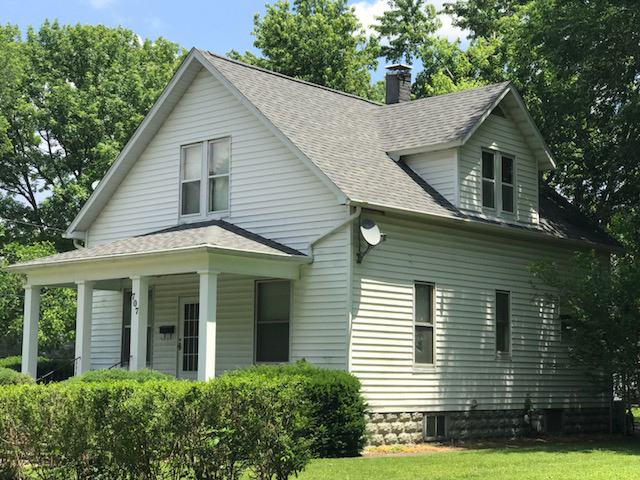 707 South Cherry Street where church founder, Henry Hoeinghaus, lived. This house is located directly behind the church.
707 South Cherry Street where church founder, Henry Hoeinghaus, lived. This house is located directly behind the church.
With the tight knit group of German Lutheran families, it was inevitable that there would be marriages among the families. William Toenningsmeyer (founder) married Caroline Gutzler; Henry Hoeinghaus (founder) married Charlotte Voigt; Fred Gutzler married Louisa Meyer; John Henry Gutzler married Lydia Brockschmidt (photo below); Gustave Toenningsmeyer married Ida Brockschmidt; Gustav Gutzler married Emma Knipping, and the list goes on.
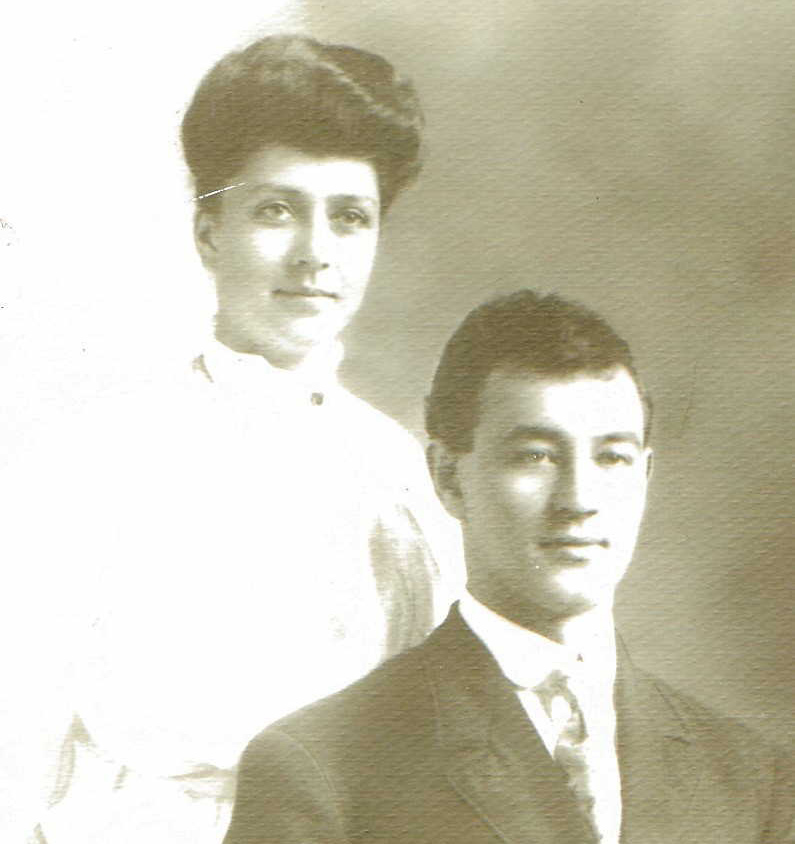 John Henry Gutzler married Lydia Brockschmidt. John Henry died in the 1947 Centralia № 5 mine disaster.5
John Henry Gutzler married Lydia Brockschmidt. John Henry died in the 1947 Centralia № 5 mine disaster.5
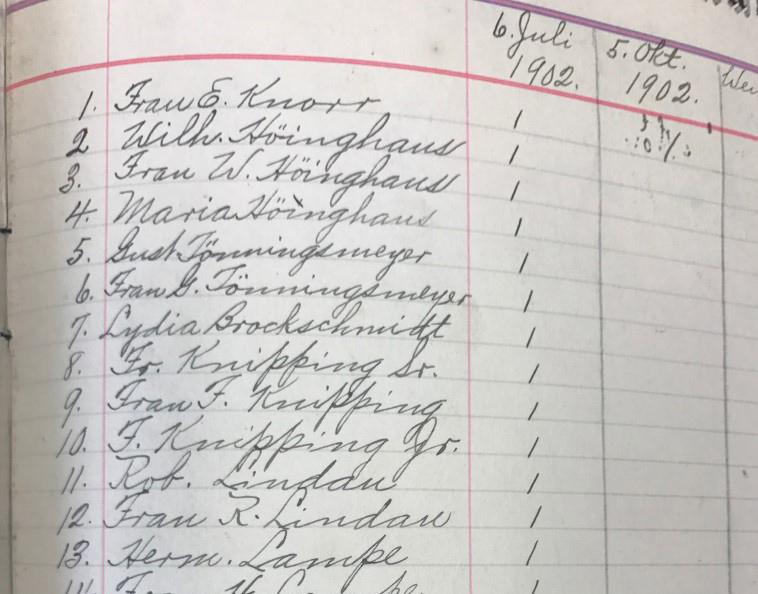 1902 church register listing family members, Hoeinghaus, Brockschmidt, Knipping and Toenningsmeyer.5
1902 church register listing family members, Hoeinghaus, Brockschmidt, Knipping and Toenningsmeyer.5
In 1903, my 2nd great grandmother, Caroline Hoeinghaus, became pregnant out of wedlock. She was nineteen. Bill Toenningsmeyer Jr., the son of church founder, William Toenningsmeyer Sr., was the father. When Caroline's father, Henry Hoeinghaus, and Bill Toenningsmeyer Jr's father, William Sr., found out about the pregnancy, they did not consent for the young couple to marry. Caroline was forced, by her father, to marry Edward Simpkin (as indicated in the church record below) which she did on December 17, 1903. Her son, Sylvester, was born in May 1904. The marriage to Edward Simpkin did not last long, and on October 21, 1907 Caroline married Oscar Alvin Johnson in Paducah, Kentucky. Oscar adopted Caroline's son, Sylvester (my great-grandfather). 7
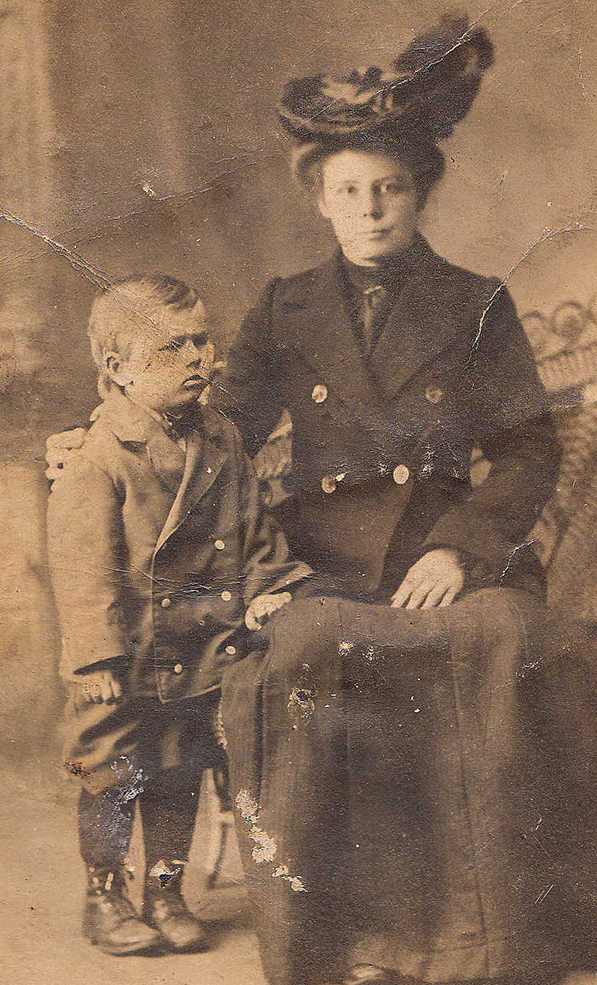 Caroline Hoeinghaus with son, Sylvester.
Caroline Hoeinghaus with son, Sylvester.
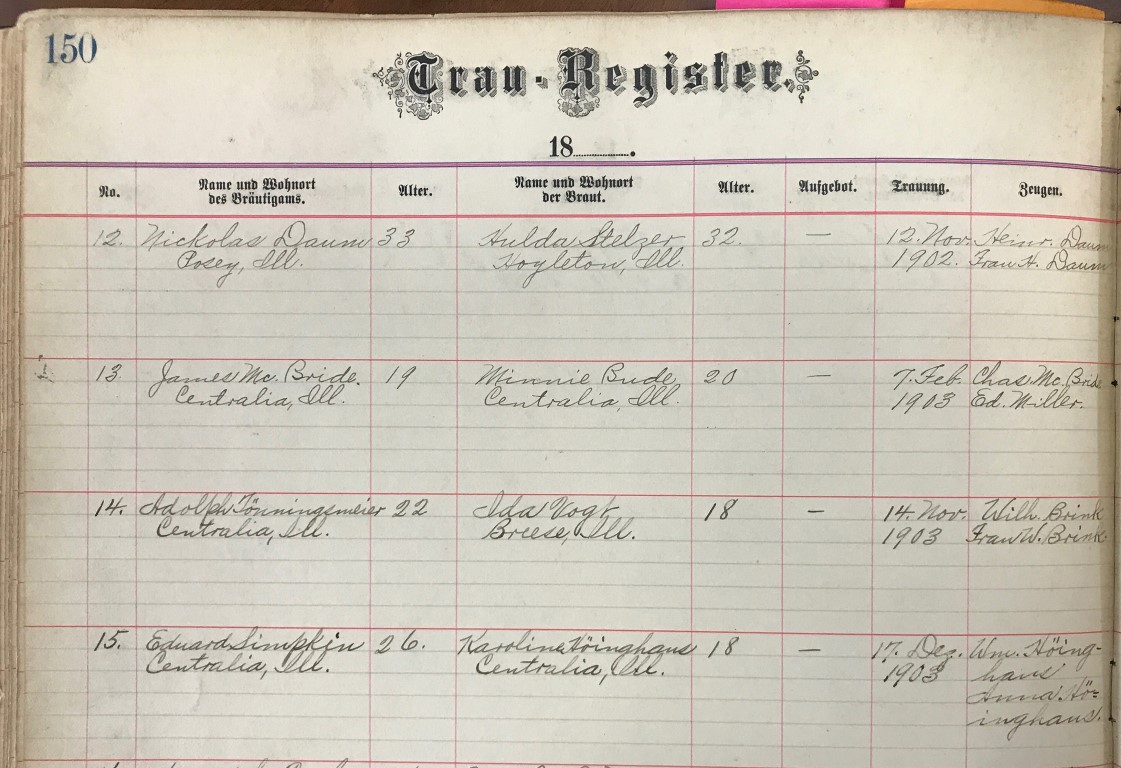 Church record of Caroline Hoeinghaus' marriage to Edward Simpkin on December 17, 1903. She was already 4 months pregnant and would give birth
to Sylvester in May 1904. 9
Church record of Caroline Hoeinghaus' marriage to Edward Simpkin on December 17, 1903. She was already 4 months pregnant and would give birth
to Sylvester in May 1904. 9
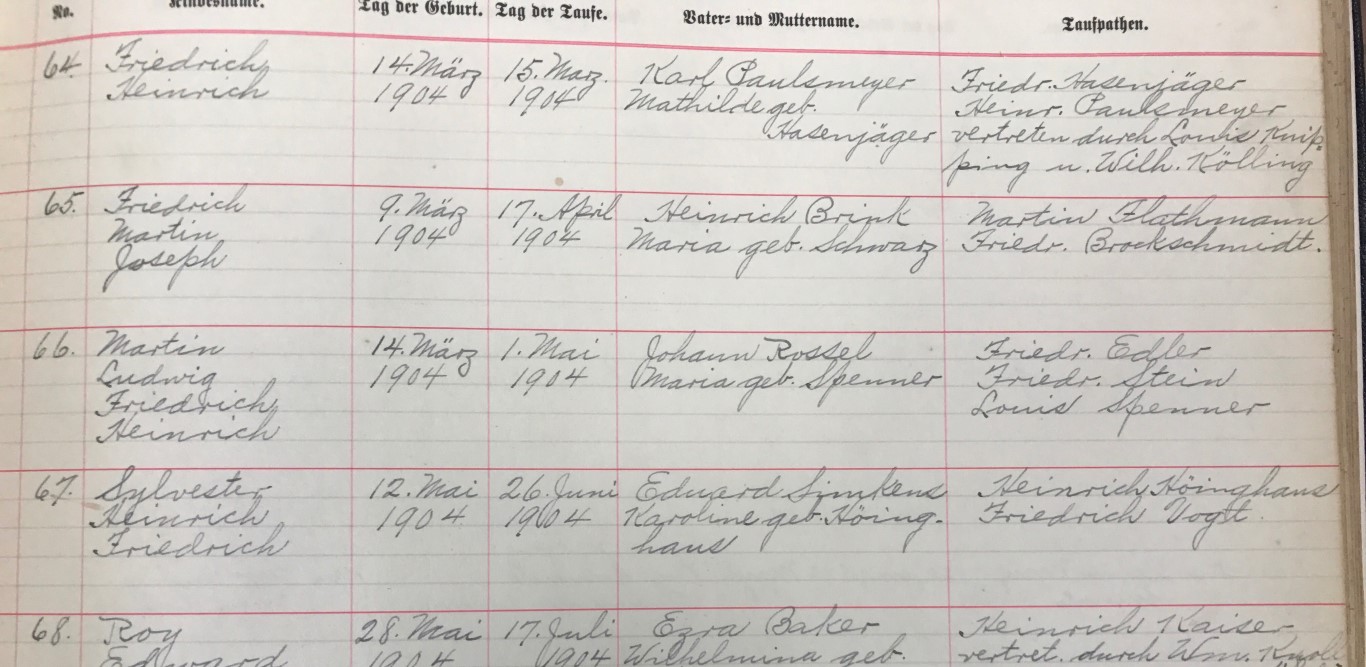 1904 baptisms of Sylvester, Heinrich and Friedrich, parents (and step-parents) listed as Edward Simpkin and Karoline (Caroline) Hoeinghaus, Godparents,
Heinrich (Henry) Hoeinghaus and Friedrich Vogt. 9
1904 baptisms of Sylvester, Heinrich and Friedrich, parents (and step-parents) listed as Edward Simpkin and Karoline (Caroline) Hoeinghaus, Godparents,
Heinrich (Henry) Hoeinghaus and Friedrich Vogt. 9
Years later, in 1992, the story of my great-grandfather's (Sylvester) out of wedlock birth was disclosed by my great-grandmother, Frances Maroon Johnson, in letters written for their children. In those letters Frances remarks how Butch (Sylvester) had always been burdened by the story, but felt that, with the Trinity Lutheran church celebrating its 100th Anniversary in 1992 (as featured in a huge write up in the Centralia Sentinel), the time was right to tell the children about it. The letter, excerpts below, that Frances wrote to my grandmother, shares the story as told by Caroline Hoeinghaus. 5
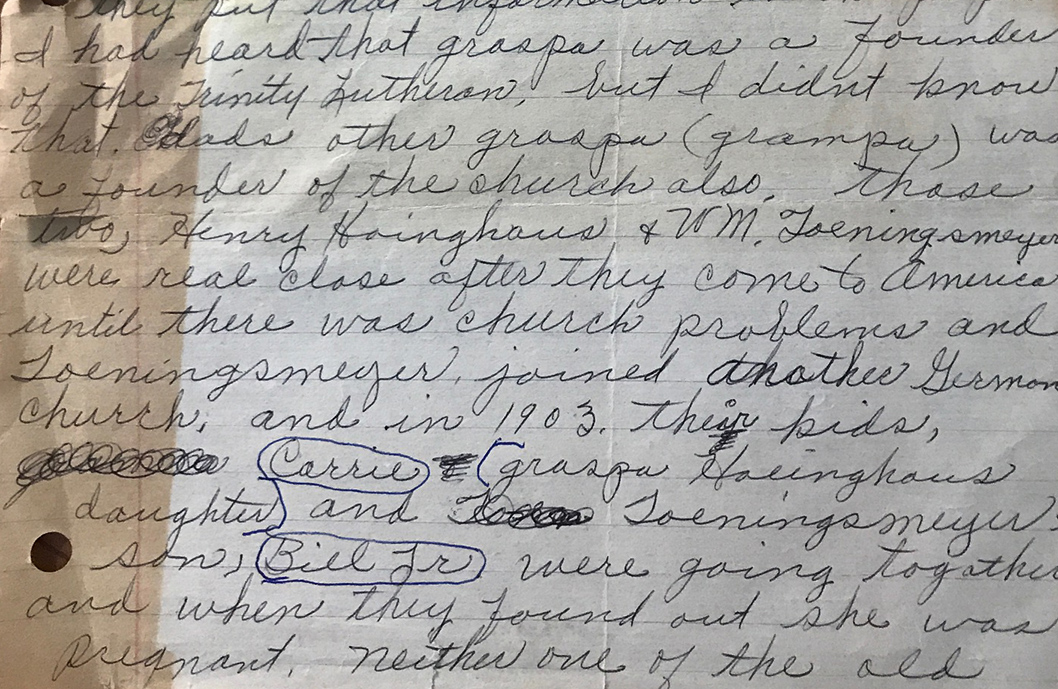 continued...
continued...
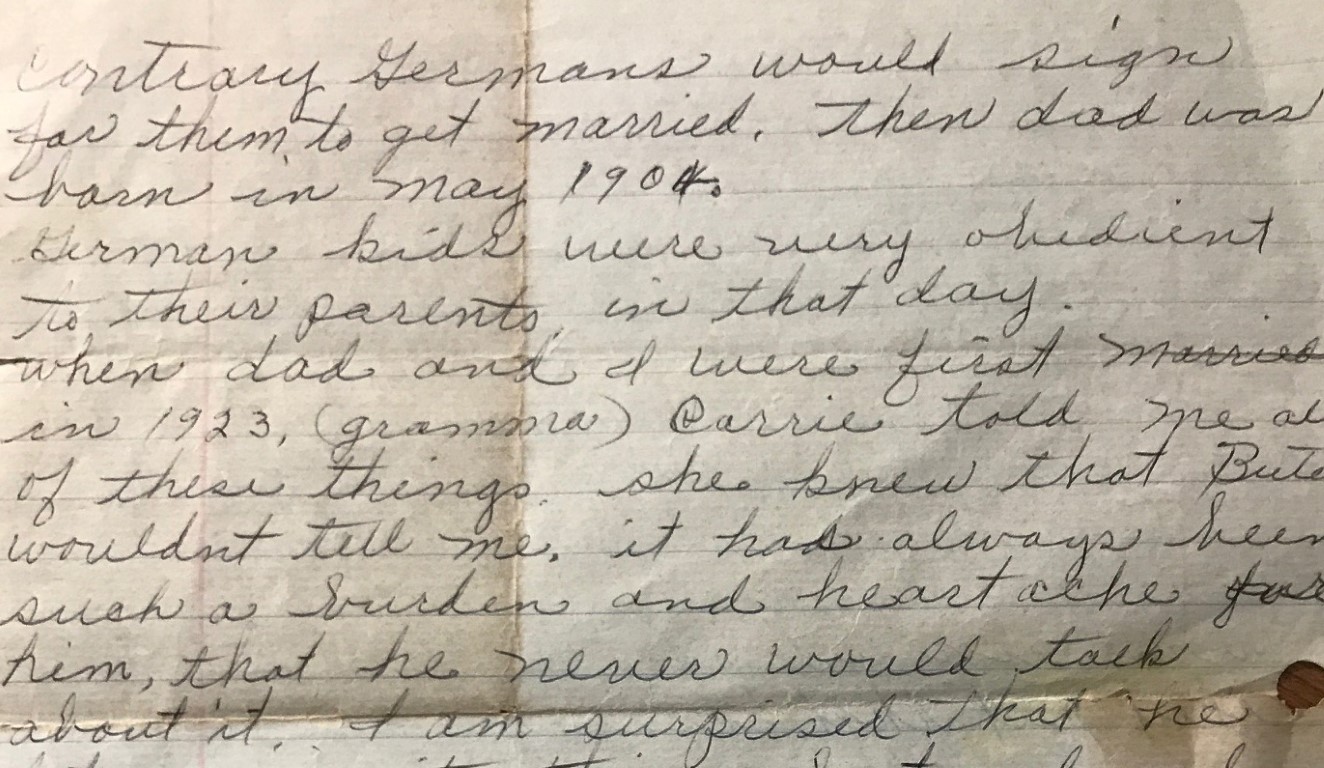 Letter from Frances Maroon Johnson, written to her kids, recounting the out of wedlock birth of Sylvester as told by
her mother-in-law, Caroline Hoeinghaus Johnson. 7
Letter from Frances Maroon Johnson, written to her kids, recounting the out of wedlock birth of Sylvester as told by
her mother-in-law, Caroline Hoeinghaus Johnson. 7
When the Illinois Central Railroad came to Centralia in 1853, the town flourished. Engines were wood burning and with a shortage of wood, there was a need for a better source of fuel. In 1874, coal was discovered 600 feet below the surface and as a result, coal mining became the second largest industry in the town (railroad was first). There were several mines in the area, No.5 mine in south Centralia, Nos. 3 and 4 near midtown, one in Odin and two in Sandoval.
By 1890, men from the German immigrant families were working in the mines. Immigrants were experienced coal miners, and in a town where the industry was new, they easily found work. In 1947 the average age of the coal miners working in the Centralia mines was fifty-nine. Members of the Gutzler, Toenningsmeyer, Voigt and Hoeinghaus families all worked in local mines.
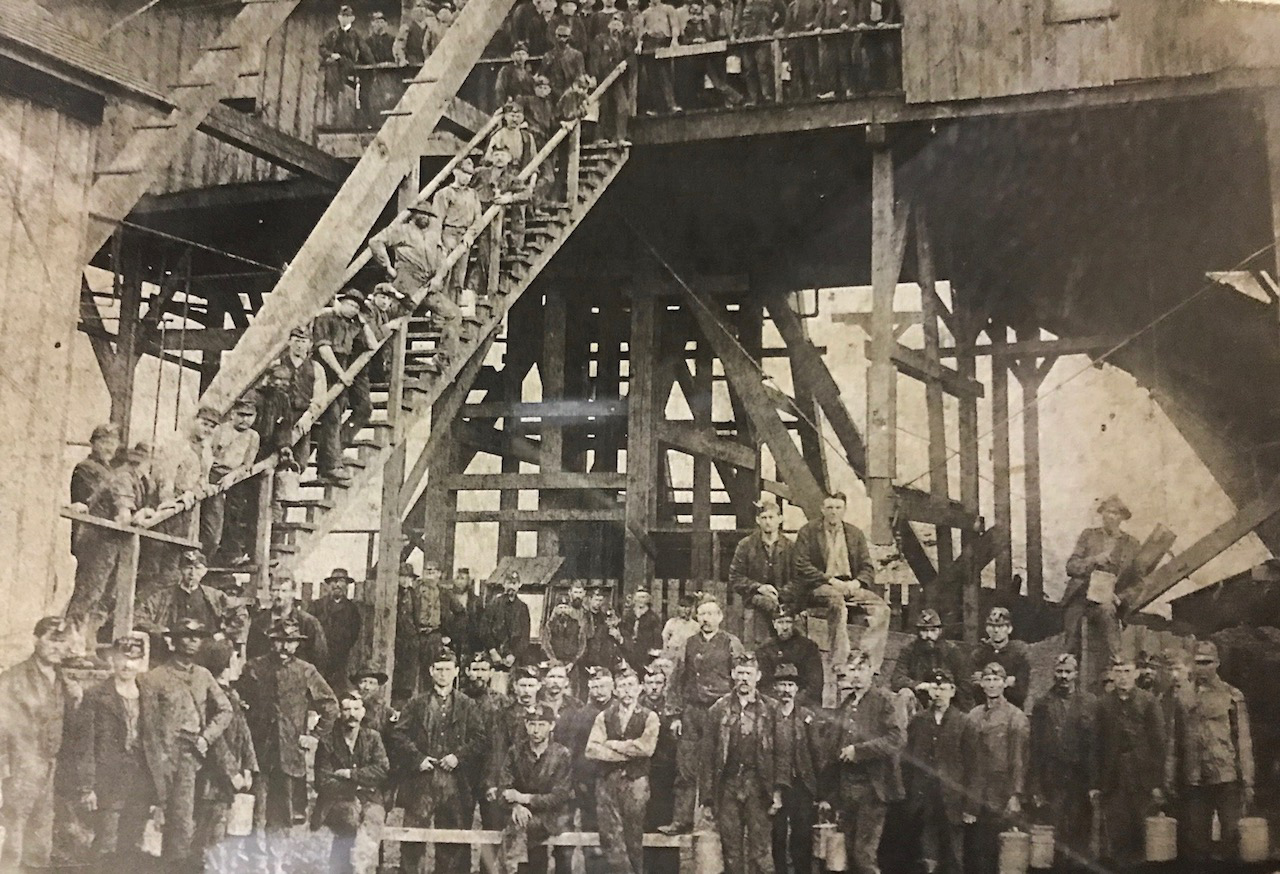 This turn of the century photo shows a full shift of miners at the tipple of the old No. 4 Pittenger and Davis Mine, located on the north end of town.
The picture was supplied by Mrs. E.H. Oestreich. Among others in the picture are Fred and John Gutzler, Louis Kruckemeyher, William Hoeinghaus, Ernest Heskemeyer and William Hammamann.
From the Centralia Sentinel.
This turn of the century photo shows a full shift of miners at the tipple of the old No. 4 Pittenger and Davis Mine, located on the north end of town.
The picture was supplied by Mrs. E.H. Oestreich. Among others in the picture are Fred and John Gutzler, Louis Kruckemeyher, William Hoeinghaus, Ernest Heskemeyer and William Hammamann.
From the Centralia Sentinel.
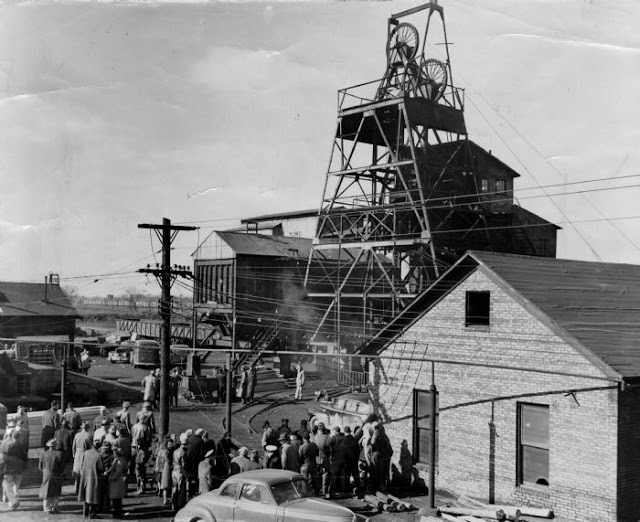 Centralia Coal Company's Mine № 5 in Wamac (southern Centralia), Illinois. St. Louis Post-Dispatch.
Centralia Coal Company's Mine № 5 in Wamac (southern Centralia), Illinois. St. Louis Post-Dispatch.
March 25, 1947 started like any other day at the № 5 mine. After a ninety minute trek to their worksite, miners, working in groups, in rooms spread throughout the mine, removed coal from the mine face. The coal was then hauled to rail cars which would carry it to locations where it would then be hoisted to the surface. As typically done at the end of each day shift, drillers set charges to blast new coal from the mine face. The charges were only allowed to detonate (in accordance with Illinois law) when the miners were safely in the hoisting shaft, heading to the surface at the end of their shift. At 3:26pm, just before the day shift ended, a huge explosion shattered the underground tunnels, nearly four miles back into the mine. 6
For years, miners had complained about the build up of coal dust in the № 5 mine, writing letters to state official and the governor of Illinois. However, before the explosion, inspectors determined that the amount of coal dust was no more than usual. It was later determined that it was a coal dust explosion. 6
"When the sirens blew at 3:26 pm on Tuesday, March 25th, the women knew. They grabbed their babies and ran through the cold March wind to the gate. Smoke was billowing out of Mine № 5 and the onlookers were ordered to stand back by the mine officials of the Centralia Coal Company. By evening, the silent crowd had grown to 500. The rain turned to snow. The waiters clustered in groups of families and friends. Some waited at the gate; others sat on the benches in the wash-house where the men changed into their work clothes in the morning." 11
It would be days before the extent of lives lost in the explosion would be known. In all, one hundred and eleven miners died. Sixty-five were killed instantly, and forty six died hours later as poisonous gas filled the the rooms and passageways. Those who were not killed instantly huddled in rooms and tried to find fresh air before the dreaded "Black Damp" would overtake them. Some had opportunity to write notes to their families in the dark. When rescuers reached the men they found a message scratched on the wall to look in the miner's pockets for notes to give their families.
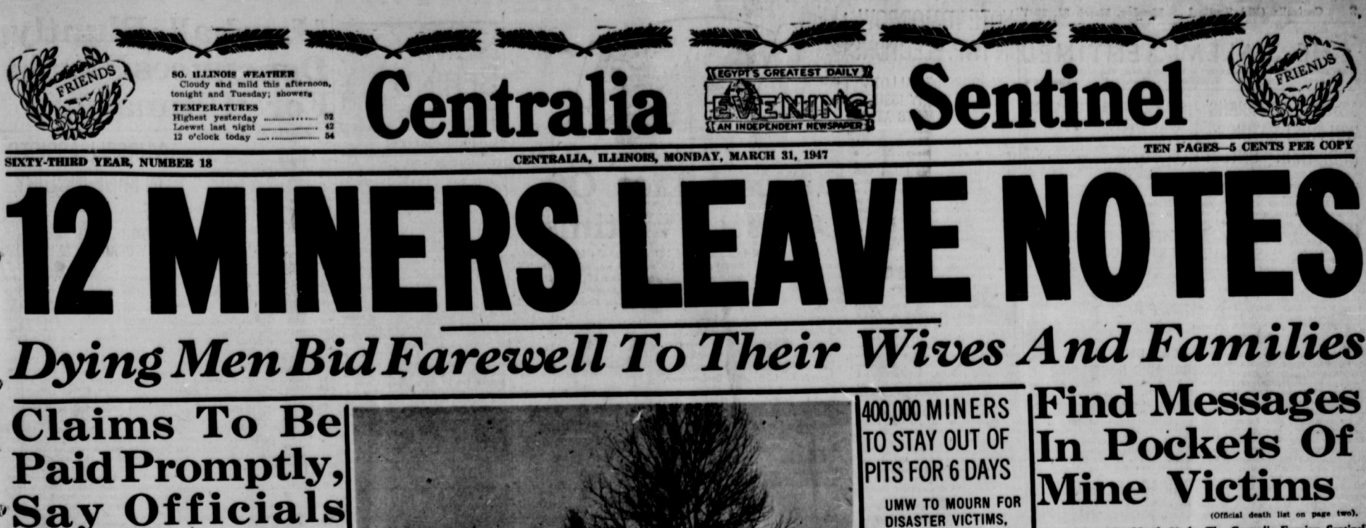 Centralia Sentinel, March 31, 1947.
Centralia Sentinel, March 31, 1947.
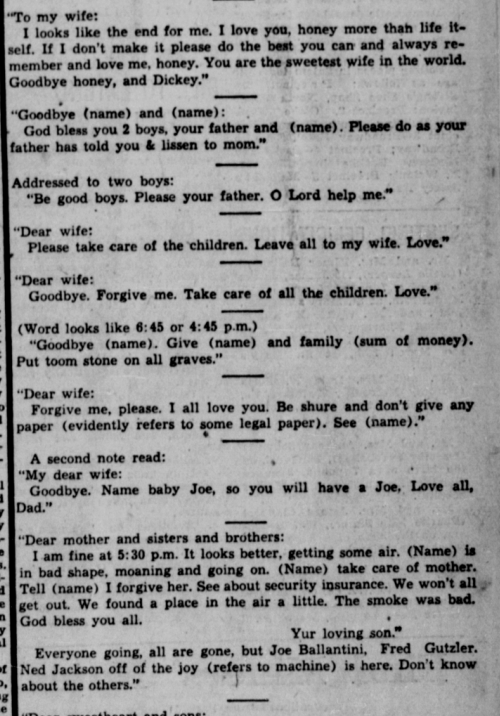 From the Centralia Sentinel, March 31, 1947.
From the Centralia Sentinel, March 31, 1947.
Trinity Lutheran Church lost nine members of their congregation in the mine explosion, including four from the Gutzler family alone: Adolph (machine helper, 48), Fred W. (driller, 50), John H. (machine man, 63) and John W. (foreman, 54). Henry Hoeinghaus, one of the founders of the church, lost his son, Henry Jr. (motorman, 56). The explosion left ninety-nine widows and seventy-eight children without fathers. The mayor of Centralia raised $20,000 to divide amongst the families to help bury their dead. 6 11
"On Satuday the search was over and Centralia went about the grim task of burying their dead. Rescued miners assisted in digging graves for their fellow workers. Funerals were schedule nearly every hour, at every funeral home and church. Flowers were hard to get and even caskets had to be shipped in. The funeral homes hardly had enough space and as many as 11 bodies might be in one small room. Only the earliest victims brought to the surface had open caskets. All others were closed." 13
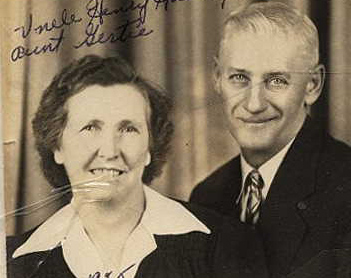 Henry Hoeinghaus, Jr., son of Henry Hoeinginghaus Sr. and Caroline's brother, died in the mine explosion.
Henry Hoeinghaus, Jr., son of Henry Hoeinginghaus Sr. and Caroline's brother, died in the mine explosion.
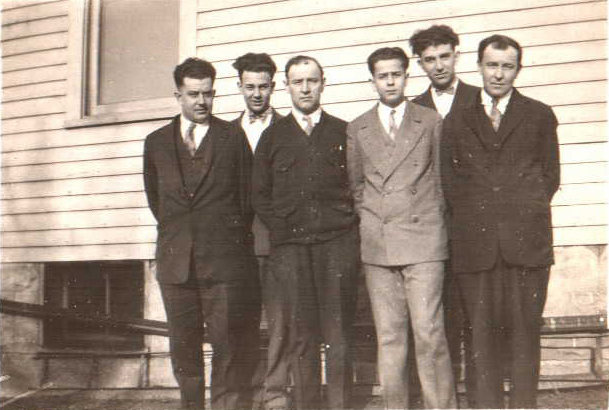 Gutzler family members: Paul, Valentine, John, Rudy, Walter and Fred Gutzler. John and Fred died in the 1947 Centralia № 5 mine disaster.5
Gutzler family members: Paul, Valentine, John, Rudy, Walter and Fred Gutzler. John and Fred died in the 1947 Centralia № 5 mine disaster.5
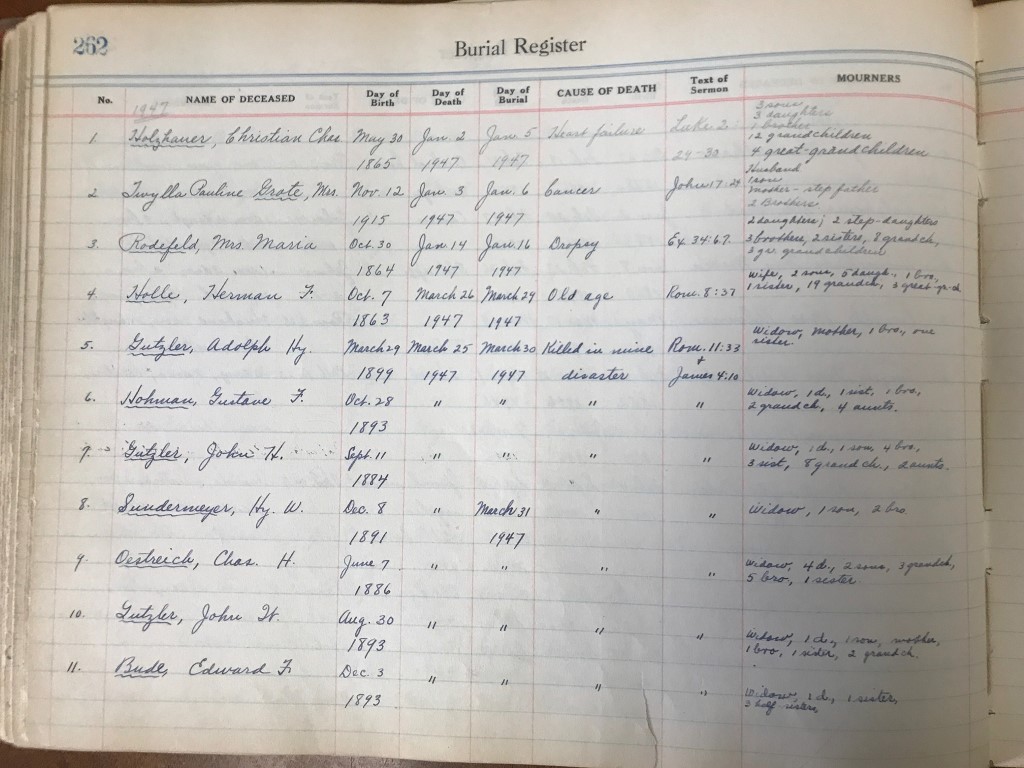 A partial list of the burials of church members who were killed in the mining disaster from the Trinity Lutheran Church archives. 9
A partial list of the burials of church members who were killed in the mining disaster from the Trinity Lutheran Church archives. 9
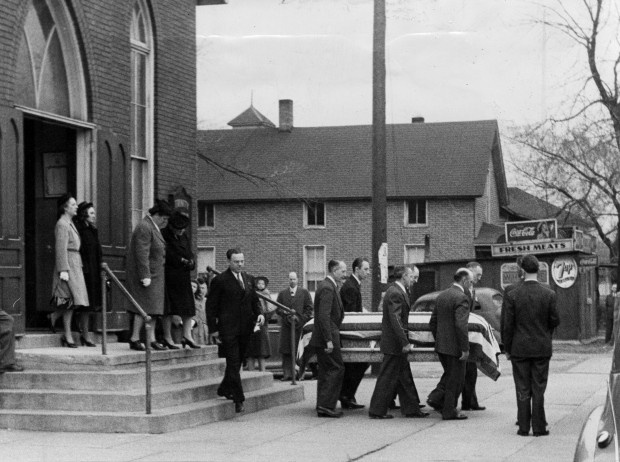 Pall bearers carry the casket of miner Edward Bude, 54, from Trinity Lutheran Church in Centralia after a funeral service on March 31, 1947.
Bude was among the 111 killed in № 5. Following in black is his widow. You can see the Trinity Lutheran school steeple over the top of the building across the street.
St. Louis Dispatch.
Pall bearers carry the casket of miner Edward Bude, 54, from Trinity Lutheran Church in Centralia after a funeral service on March 31, 1947.
Bude was among the 111 killed in № 5. Following in black is his widow. You can see the Trinity Lutheran school steeple over the top of the building across the street.
St. Louis Dispatch.
The entrance to Centralia № 5 mine is sealed. Officially closed a few years after the explosion, the entrance was covered with concrete. A 1998 news article from the Centralia Sentinel reported that, though the mine was sealed in the 1950's, the shaft still descended 135 feet. The article went on to suggest that the state planned to, later that year, "seal the site permanently with shot rock, 51 tons of riprap and 54 tons of course aggregate, and then reinforce it by a concrete cap." 11
The old mine entrance is difficult to find today. Based on my research, I believe it to be located between the old coaling tower (photo below) and a nearby junkyard. On a recent visit to the site I searched for any signs of the original mine shaft but could not identify its exact location.
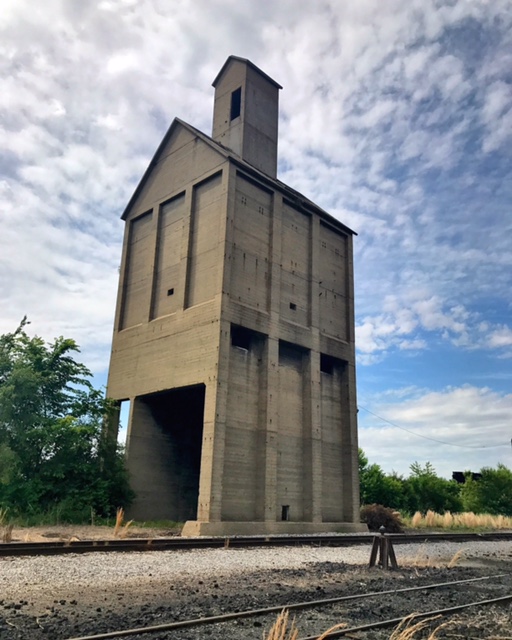 Coal tower in Wamac.
Coal tower in Wamac.
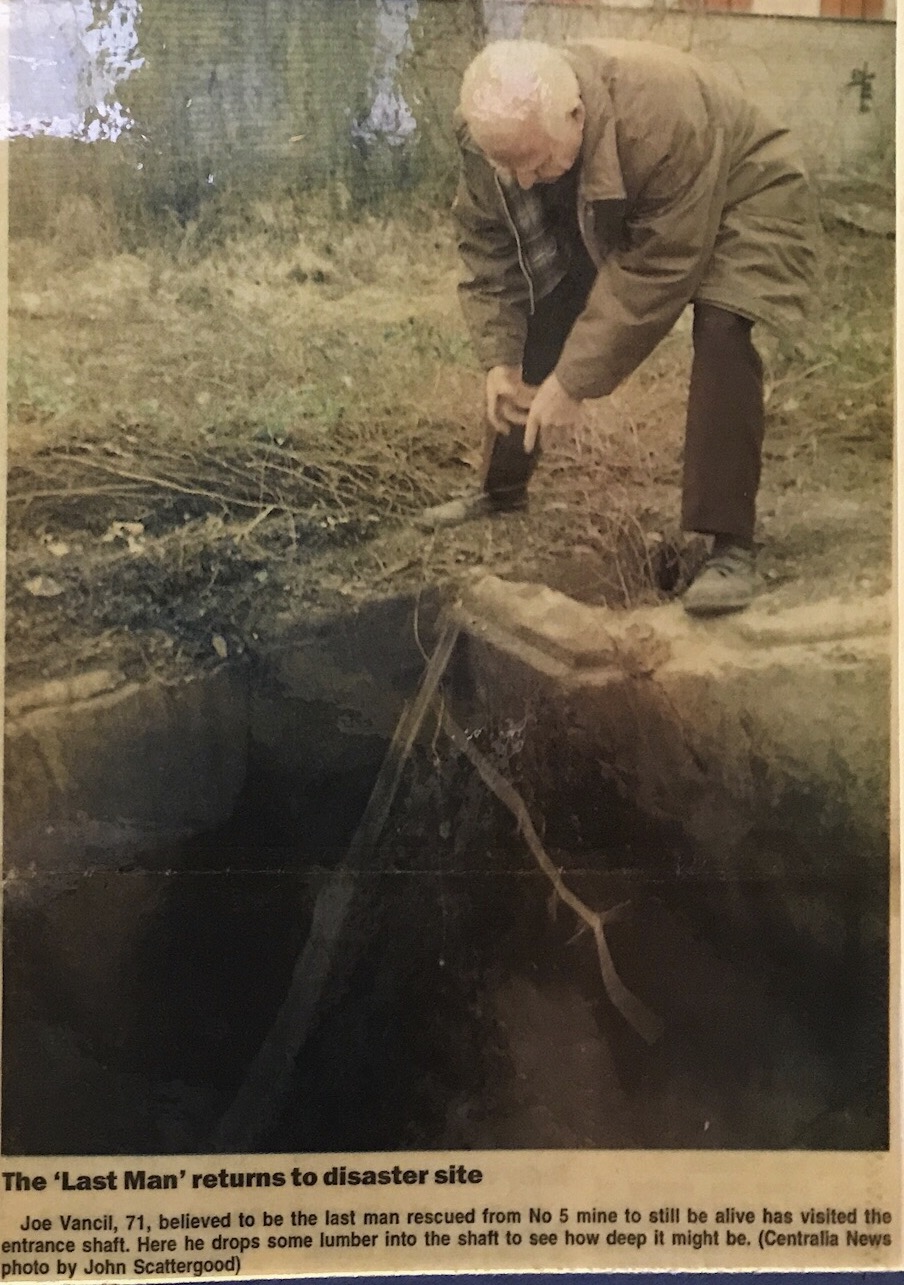 Article from the Centralia History Museum.
Article from the Centralia History Museum.
In 1941 a church building committee was appointed to oversee the construction of a new sanctuary and school. However, the efforts were delayed with the onset of World War II and then again with the Centralia № 5 mine disaster in 1947. In April 1950 a site was purchased on South Pleasant Street and construction began on a new school and social hall which was completed in November 1952. A new church building and parsonage were built in 1957.
The original church on South Hickory and South Cherry Street was vacated and sold to the newly organized congregation of the Hickory Street Christian Church. The old school building was remodeled for use as a dwelling house. The Hickory Street Christian Church stayed in the building until 1985 at which time they moved to Calumet Street. The building was sold June 1, 1985 and may have been used as a day care center before being abandoned and condemned.
The old Trinity Lutheran church building is now quiet and slowly degrading. No more church services, school lessons, weddings, baptisms or burials. The lives of some of the people who attended the church a century ago are unknown, only imagination can fill the gaps. The stories that are known, however, are quite fascinating, providing an interesting glimpse into another time and way of life. The old church will be torn down and forgotten one day, but its story won't, nor the lives of the people it was a part of.
 View of the church from West 8th Street. At same point the exterior of the church, as well as the interior, went through extensive renovations.
View of the church from West 8th Street. At same point the exterior of the church, as well as the interior, went through extensive renovations.
 An inside view of the church in early years. 9
An inside view of the church in early years. 9
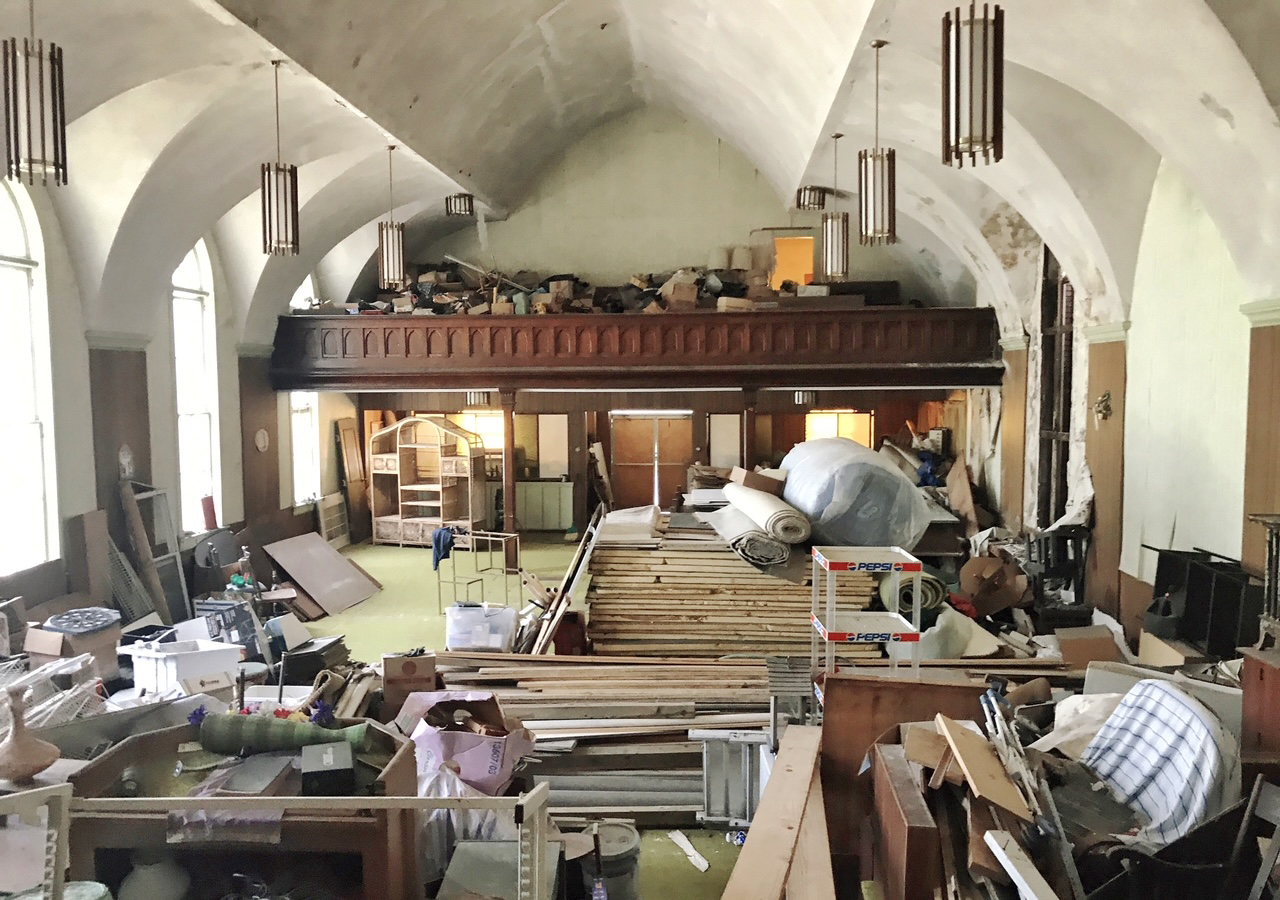 Same view of balcony today.
Same view of balcony today.
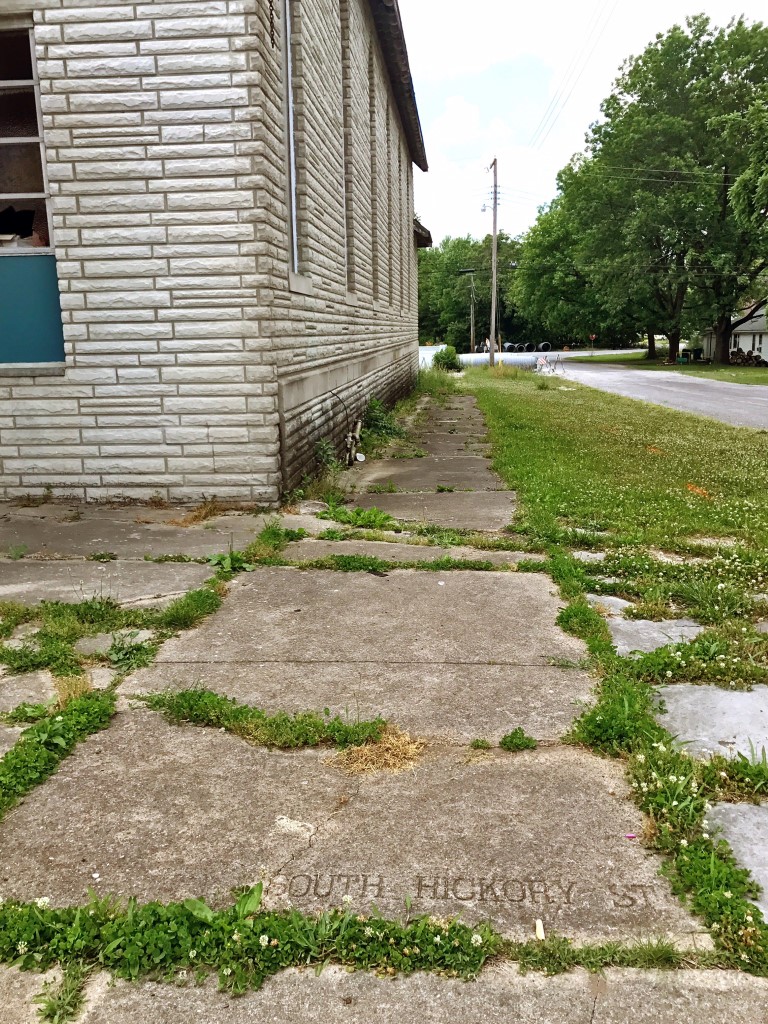 On the north side of the church, "South Hickory St" carved into the sidewalk.
On the north side of the church, "South Hickory St" carved into the sidewalk.
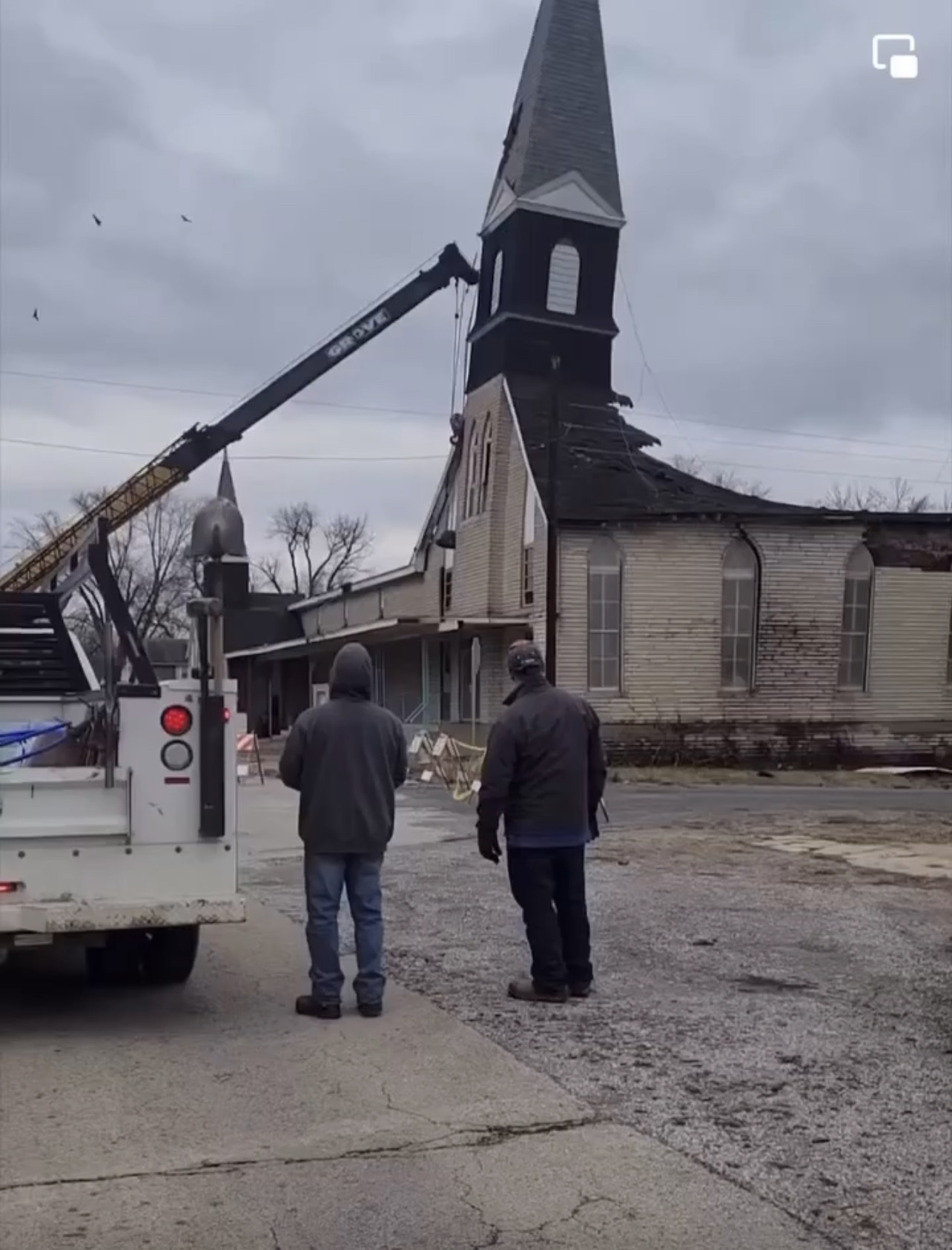 The update this blog, the Trinity Lutheran Church was torn down in 2022.
See VIDEO
The update this blog, the Trinity Lutheran Church was torn down in 2022.
See VIDEO
Author's note: A special thank you to Dreama Phelps and the Trinity Lutheran Church of Centralia, Illinois for their assistance in providing the church's historic records for research.
There are variations to the spelling of the names Toenningsmeyer (Toenningsmeier, Toeningsmeier) and Voigt (Vogt, Voight)